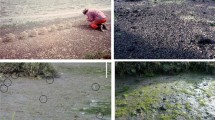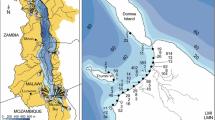Abstract
Managing invasive species requires information about their distributions and potential effects, but community-level impacts of invasive animals remain poorly understood. The Chinese mystery snail (Bellamya chinensis) is a large invasive gastropod that achieves high densities in waters across North America, yet little is known about its ecological significance in invaded systems. We surveyed 44 lakes to describe the patterns and determinants of B. chinensis distributions in northern Wisconsin, USA, and to assess the likelihood of effects on native snail communities in the invaded systems. B. chinensis was widespread among surveyed lakes (21 of 42 lakes with snails) and its occurrence was correlated with indicators of lake productivity and anthropogenic dispersal vectors (boat landings, distance to population centers, shoreline housing density). Some native snail species tended not to occur at sites where B. chinensis was abundant; among these was Lymnaea stagnalis, which suffered reduced survival in the presence of B. chinensis in a recently published mesocosm study. However, there was no difference in overall snail assemblage structure at either the site or lake level as a function of B. chinensis presence or abundance. Lake occurrences of many snail species have apparently been lost over time, but a comparison to a 1930s survey showed that there was no increased likelihood of species loss in lakes invaded by B. chinensis (or by the invasive crayfish Orconectes rusticus). Although B. chinensis is widespread and sometimes abundant in northern Wisconsin lakes, it does not appear to have strong systematic impacts on native snail assemblages.





Similar content being viewed by others
References
Adam ME, Lewis JW (1992) The lack of coexistence between Lymnaea peregra and Lymnaea auricularia (Gastropoda, Pulmonata). J Molluscan Stud 58:227–231
Agresti A (2002) Categorical data analysis, 2nd edn. Wiley, Hoboken
Aho J (1966) Ecological basis of the distribution of the littoral freshwater molluscs in the vicinity of Tampere, South Finland. Ann Zool Fenn 3:287–322
Anderson MJ (2001) A new method for non-parametric multivariate analysis of variance. Austral Ecol 26:32–46
Babler AL, Solomon CT, Schilke P (2008) Depth-specific patterns of benthic secondary production in an oligotrophic lake. J North Am Benthol Soc 27:108–119
Baker FC (1928) The fresh water Mollusca of Wisconsin. State of Wisconsin, Madison
Branstrator DK, Brown ME, Shannon LJ, Thabes M, Heimgartner K (2006) Range expansion of Bythotrephes longimanus in North America: evaluating habitat characteristics in the spread of an exotic zooplankter. Biol Invasions 8:1367–1379
Bronmark C (1985) Fresh water snail diversity—effects of pond area, habitat heterogeneity and isolation. Oecologia 67:127–131
Brown KM (1982) Resource overlap and competition in pond snails—an experimental analysis. Ecology 63:412–422
Buchan LAJ, Padilla DK (1999) Estimating the probability of long-distance overland dispersal of invading aquatic species. Ecol Appl 9:254–265
Burch JB (1989) North American freshwater snails. Malacological Publications, Hamburg
Bury JA, Sietman BE, Karns BN (2007) Distribution of the non-native Viviparid snails, Bellamya chinensis and Viviparus georgianus, in Minnesota and the first record of Bellamya japonica from Wisconsin. J Freshw Ecol 22:697–703
Carlsson NOL, Bronmark C, Hansson LA (2004) Invading herbivory: the golden apple snail alters ecosystem functioning in Asian wetlands. Ecology 85:1575–1580
Carpenter SR, Benson BJ, Biggs R, Chipman JW, Foley JA, Golding SA, Hammer RB, Hanson PC, Johnson PTJ, Kamarainen AM, Kratz TK, Lathrop RC, McMahon KD, Provencher B, Rusak JA, Solomon CT, Stanley EH, Turner MG, Vander Zanden MJ, Wu C-H, Yuan H (2007) Understanding regional change: a comparison of two lake districts. Bioscience 57:323–335
Davis MA (2003) Biotic globalization: does competition from introduced species threaten biodiversity? Bioscience 53:481–489
Dillon RT Jr (2000) The ecology of freshwater molluscs. Cambridge University Press, Cambridge
Hall R, Tank JL, Dybdahl MF (2003) Exotic snails dominate nitrogen and carbon cycling in a highly productive stream. Front Ecol Environ 1:407–411
Hall RO, Dybdahl MF, VanderLoop MC (2006) Extremely high secondary production of introduced snails in rivers. Ecol Appl 16:1121–1131
Hanson PC, Carpenter SR, Cardille JA, Coe MT, Winslow LA (2007) Small lakes dominate a random sample of regional lake characteristics. Freshw Biol 52:814–822
Harman WN (1972) Benthic substrates—their effect on freshwater mollusca. Ecology 53:271–277
Heino J, Muotka T (2006) Landscape position, local environmental factors, and the structure of molluscan assemblages of lakes. Landsc Ecol 21:499–507
Hershey AE (1990) Snail populations in arctic lakes—competition mediated by predation. Oecologia 82:26–32
Hubendick B (1951) Recent Lymnaeidae. Their variation, morphology, taxonomy, nomenclature, and distribution. Kungl. Svenska Vetenskapskademiens Handlingar 3:1–233
Hubendick B (1955) Phylogeny in the Planorbidae. Trans Zool Soc Lond 28:453–542
Jass JP (2004) Distributions of gastropods in Wisconsin. Milwaukee Public Museum Contrib Biol Geol 99:1–28
Johnson PTJ, Olden JD, Vander Zanden MJ (2008) Dam invaders: impoundments facilitate biological invasions into freshwaters. Front Ecol Environ 6:359–365
Johnson PTJ, Olden JD, Solomon CT, Vander Zanden MJ (2009) Interactions among invaders: community and ecosystem effects of multiple invasive species in an experimental aquatic system. Oecologia 159:161–170
Jokinen EH (1982) Cipangopaludina chinensis (Gastropoda: Viviparidae) in North America, review and update. Nautilus 96:89–95
Kerans BL, Dybdahl ME, Gangloff MM, Jannot JE (2005) Potamopyrgus antipodarum: distribution, density, and effects on native macroinvertebrate assemblages in the greater Yellowstone ecosystem. J North Am Benthol Soc 24:123–138
Kratz TK, Webster KE, Bowser CJ, Magnuson JJ, Benson BJ (1997) The influence of landscape position on lakes in northern Wisconsin. Freshw Biol 37:209–217
Kruskal JB (1964) Multidimensional scaling by optimizing goodness of fit to a nonmetric hypothesis. Psychometrika 29:1–27
Lewis DB, Magnuson JJ (2000) Landscape spatial patterns in freshwater snail assemblages across Northern Highland catchments. Freshw Biol 43:409–420
Lodge DM, Brown KM, Klosiewski SP, Stein RA, Covich AP, Leathers BK, Bronmark C (1987) Distribution of fresh water snails—spatial scale and the relative importance of physicochemical and biotic factors. Am Malacol Bull 5:73–84
Lodge DM, Kershner MW, Aloi JE, Covich AP (1994) Effects of an omnivorous crayfish (Orconectes rusticus) on a fresh water littoral food web. Ecology 75:1265–1281
Lodge DM, Stein RA, Brown KM, Covich AP, Bronmark C, Garvey JE, Klosiewski SP (1998) Predicting impact of freshwater exotic species on native biodiversity: challenges in spatial scaling. Aust J Ecol 23:53–67
Lydeard C, Cowie RH, Ponder WF, Bogan AE, Bouchet P, Clark SA, Cummings KS, Frest TJ, Gargominy O, Herbert DG, Hershler R, Perez KE, Roth B, Seddon M, Strong EE, Thompson FG (2004) The global decline of nonmarine mollusks. Bioscience 54:321–330
Lysne SJ, Perez KE, Brown KM, Minton RL, Sides JD (2008) A review of freshwater gastropod conservation: challenges and opportunities. J North Am Benthol Soc 27:463–470
MacIsaac HJ, Borbely JVM, Muirhead JR, Graniero PA (2004) Backcasting and forecasting biological invasions of inland lakes. Ecol Appl 14:773–783
McCarthy JM, Hein CL, Olden JD, Vander Zanden MJ (2006) Coupling long-term studies with meta-analysis to investigate impacts of non-native crayfish on zoobenthic communities. Freshw Biol 51:224–235
McCune B, Mefford MJ (1999) PC-ORD: multivariate analysis of ecological data. MjM Software, Gleneden Beach
Mercado-Silva N, Olden JD, Maxted JT, Hrabik TR, Vander Zanden MJ (2006) Forecasting the spread of invasive rainbow smelt in the Laurentian Great Lakes region of North America. Conserv Biol 20:1740–1749
Mills EL, Leach JH, Carlton JT, Secor CL (1993) Exotic species in the Great Lakes—a history of biotic crises and anthropogenic introductions. J Great Lakes Res 19:1–54
Morrison JPE (1932) A report on the Mollusca of the northeastern Wisconsin lake district. Trans Wisconsin Acad Sci Arts Lett 27:359–396
Oksanen J, Kindt R, Legendre P, O’Hara B, Simpson G, Henry M, Stevens H, Wagner H (2008) Community ecology package (vegan). R Foundation for Statistical Computing, Vienna
Parker IM, Simberloff D, Lonsdale WM, Goodell K, Wonham M, Kareiva PM, Williamson MH, Von Holle B, Moyle PB, Byers JE, Goldwasser L (1999) Impact: toward a framework for understanding the ecological effects of invaders. Biol Invasions 1:3–19
Peterson AT (2003) Predicting the geography of species’ invasions via ecological niche modeling. Q Rev Biol 78:419–433
Pointier JP, McCullough F (1989) Biological control of the snail hosts of Schistosoma mansoni in the Caribbean area using Thiara spp. Acta Trop 46:147–155
Pysek P, Richardson DM, Pergl J, Jarosik V, Sixtova Z, Weber E (2008) Geographical and taxonomic biases in invasion ecology. Trends Ecol Evol 23:237–244
R Development Core Team (2008) R: a language and environment for statistical computing. R Foundation for Statistical Computing, Vienna
Reed-Andersen T, Bennett EM, Jorgensen BS, Lauster G, Lewis DB, Nowacek D, Riera JL, Sanderson BL, Stedman R (2000) Distribution of recreational boating across lakes: do landscape variables affect recreational use? Freshw Biol 43:439–448
Ricciardi A, Atkinson SK (2004) Distinctiveness magnifies the impact of biological invaders in aquatic ecosystems. Ecol Lett 7:781–784
Rosenthal SK, Stevens SS, Lodge DM (2006) Whole-lake effects of invasive crayfish (Orconectes spp.) and the potential for restoration. Can J Fish Aquat Sci 63:1276–1285
Sax DF, Stachowicz JJ, Brown JH, Bruno JF, Dawson MN, Gaines SD, Grosberg RK, Hastings A, Holt RD, Mayfield MM, O’Connor MI, Rice WR (2007) Ecological and evolutionary insights from species invasions. Trends Ecol Evol 22:465–471
Schindler DE, Scheuerell MD (2002) Habitat coupling in lake ecosystems. Oikos 98:177–189
Smith DG (2000) Notes on the taxonomy of introduced Bellamya (Gastropoda: Viviparidae) species in northeastern North America. Nautilus 114:31–37
Strayer DL (2006) Challenges for freshwater invertebrate conservation. J North Am Benthol Soc 25:271–287
Strayer DL, Eviner VT, Jeschke JM, Pace ML (2006) Understanding the long-term effects of species invasions. Trends Ecol Evol 21:645–651
Teskey MC (1954) The mollusks of Brown County, Wisconsin. Nautilus 68:24–28
Turner AM, Turner RR, Ray SR (2007) Competition and intraguild egg predation among freshwater snails: re-examining the mechanism of interspecific interactions. Oikos 116:1895–1903
Vadeboncoeur Y, Vander Zanden MJ, Lodge DM (2002) Putting the lake back together: reintegrating benthic pathways into lake food web models. Bioscience 152:44–54
Vander Zanden MJ, Olden JD (2008) A management framework for preventing the secondary spread of aquatic invasive species. Can J Fish Aquat Sci 65:1512–1522
Wethington AR, Lydeard C (2007) A molecular phylogeny of Physidae (Gastropoda: Basommatophora) based on mitochondrial DNA sequences. J Molluscan Stud 73:241–257
Whittier TR, Ringold PL, Herlihy AT, Pierson SM (2008) A calcium-based invasion risk assessment for zebra and quagga mussels (Driessena spp). Front Ecol Environ 6:180–184
Wilson KA, Magnuson JJ, Lodge DM, Hill AM, Kratz TK, Perry WL, Willis TV (2004) A long-term rusty crayfish (Orconectes rusticus) invasion: dispersal patterns and community change in a north temperate lake. Can J Fish Aquat Sci 61:2255–2266
Wood WM (1892) Paludina japonica Mart. for sale in the San Francisco Chinese markets. Nautilus 5:114–115
Acknowledgments
We thank K. Langree and E. Vennie-Volrath for conducting the surveys. T. Kratz and the Trout Lake Station staff supported the field work in a number of ways, and conducted the regional surveys from which we derived some of our data. B. Fahey and S. Jones provided helpful statistical suggestions, L. Kursel and J. Maxted assisted with statistical and GIS analyses, and J. Jass provided information about occurrence records. This work was funded by an NSF Graduate Research Fellowship to C. Solomon, by grants from the Department of Zoology and the Center for Limnology at the University of Wisconsin (including a Carl A. Bunde award, an Anna Grant Birge award, and a Juday fellowship), by the Wisconsin Department of Natural Resources, and by the North-Temperate Lake Long-Term Ecological Research (NTL-LTER) Program.
Author information
Authors and Affiliations
Corresponding author
Electronic supplementary material
Below is the link to the electronic supplementary material.
Rights and permissions
About this article
Cite this article
Solomon, C.T., Olden, J.D., Johnson, P.T.J. et al. Distribution and community-level effects of the Chinese mystery snail (Bellamya chinensis) in northern Wisconsin lakes. Biol Invasions 12, 1591–1605 (2010). https://doi.org/10.1007/s10530-009-9572-7
Received:
Accepted:
Published:
Issue Date:
DOI: https://doi.org/10.1007/s10530-009-9572-7




